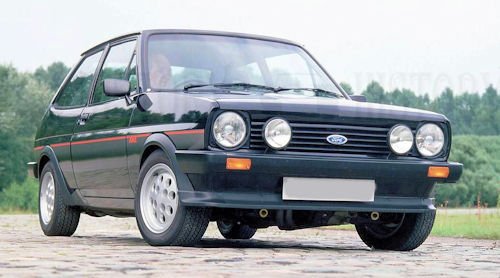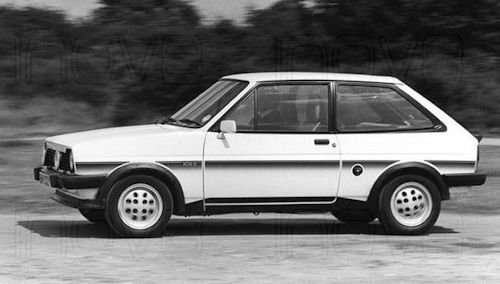Ford Fiesta XR2 mk1
 |
|
|
Production period: |
1981 to 1983 |
|
Class : |
Sports car |
|
Body versions : |
Hatch |
|
Engines: |
Petrol 1.6 liters (63 kW) |
|
Length: |
3565 mm |
|
Width: |
1567 mm |
|
Height: |
1360 mm |
|
Wheelbase : |
2286 mm |
|
Empty weight : |
730-775 kg |
While the Fiesta were marketed as XR2 , there were for the sportier models of the Escort XR3 and XR4 for the Sierra .The first was the Fiesta XR2 mk1 of the first series .
The 1.6-liter Kent engine had a displacement of 300 cc larger than the next-smaller engine in this series, producing 13 kW (18 hp) more.
Externally, the XR2 differed from the other vehicles of this model by plastic body extensions, a small tailgate, round headlights, alloy wheels, a lowered body and a sporty decor with rally type stripes. The interior included a sports steering wheel, sports seats and a tachometer as standard equipment.
With a mechanical four-speed transmission accelerated the Fiesta with 62 kW (84 hp) in 10.1 seconds to 100 km / h. The fue mixture preparation of the OHV engine was carried out by a Weber carburetor, and the ignition system was contactless .
Two-part wishbones with tension struts and MacPherson struts are installed on the front axle . The rack and pinion steering is combined with a safety steering column , but power assistance was not available as standard or optional equipment.
The rigid rear axle is guided on trailing arms , a Panhard rod and the shock absorbers and is sprung with coil springs . Unlike usual, the shock absorbers are connected to the axle tube at two points in order to absorb the braking reaction forces and prevent the axle from rotating. contrast to shock absorber struts , they can be swiveled to the side in order to enable reciprocal compression.

The XR2 is lowered and equipped with a specially tuned chassis and a stabilizer on the rear axle. With the XR2 , the Panhard rod is made of solid round material instead of a sheet steel profile.
On the front axle there are disc brakes with floating brake calipers , on the XR2 the discs are internally ventilated. Drum brakes are installed on the rear axle, and the parking brake also acts on them.
The XR2 are equipped with contactless ignition systems with an external ignition controller.
Technical
-
Technical details and specifications Fiesta 1.6 XR2 mk1 Engine code: L3E
BORE × STROKE 81 × 77.6 mm 3.19 × 3.06 in
BORE/STROKE RATIO 1.04
VALVE GEAR overhead valve (OHV) 2 valves per cylinder 8 valves in total
MAXIMUM POWER OUTPUT (DIN) 85 PS (84 bhp) (63 kW) at 5500 rpm
SPECIFIC OUTPUT(DIN) 52.6 bhp/litre 0.86 bhp/cu in
MAXIMUM TORQUE (DIN) 124 Nm (91 ft·lb) (12.6 kgm) at 2800 rpmNo. of cylinders Type 4/OHV
Capacity 1599 cc
Compression ratio 9.2:1
Suitable for unleaded petrol Yes
Fuel system Weber Type 32/34 DFTA
Ignition coil Make Lucas
Firing order 1-2-4-3
Distributor Make Motorcraft No. V821F-AA
Starter motor Make Bosch Type 0 001 211 227
Minimum starting voltage 10.0V
Alternator/Regulator Type K1-45A
Voltage regulator Type 0 192 052 005
Regulated voltage 13.7-14.5V
Fuel system pump delivery pressure 0.22-0.35 bar© motorcar history
Service
-
Ford Fiesta XR2 Mk1 Service Guide
Valve clearance -INLET 0.25mm cold
Valve clearance -EXHAUST 0,55mm cold
Oil pressure bar/rpm 1.5/2000
Radiator cap 0.9 bar
Thermostat opens 85-89 °C
Drive belt size - alternator 9.5x813mm
Engine oil grade - normal climate 10W/30 SAE or 15W/50
Engine with filter 3.3 litres
Manual gearbox oil grade 80W SAE 2.8 litres
Cooling system 6.2 litres
Spark plugs Original equipment Motorcraft Type AGPR22C
Spark plugs Electrode gap 0.6 mm
Tightening torques
Cylinder head instructions
Stage 1 Tighten 40-50 Nm
Stage 2 Tighten 80-90 Nm
Stage 3 Tighten 100-110 Nm
Spark plugs 13-20 Nm
Front hub 240-270 Nm
Road wheels 100 Nm© motorcar history
Manuals
Media
Ford Fiesta Mk1 (1976-1983)
Author Motor car History Duration 02:42-
Ford (europe) Previous 53 / 128 Next
